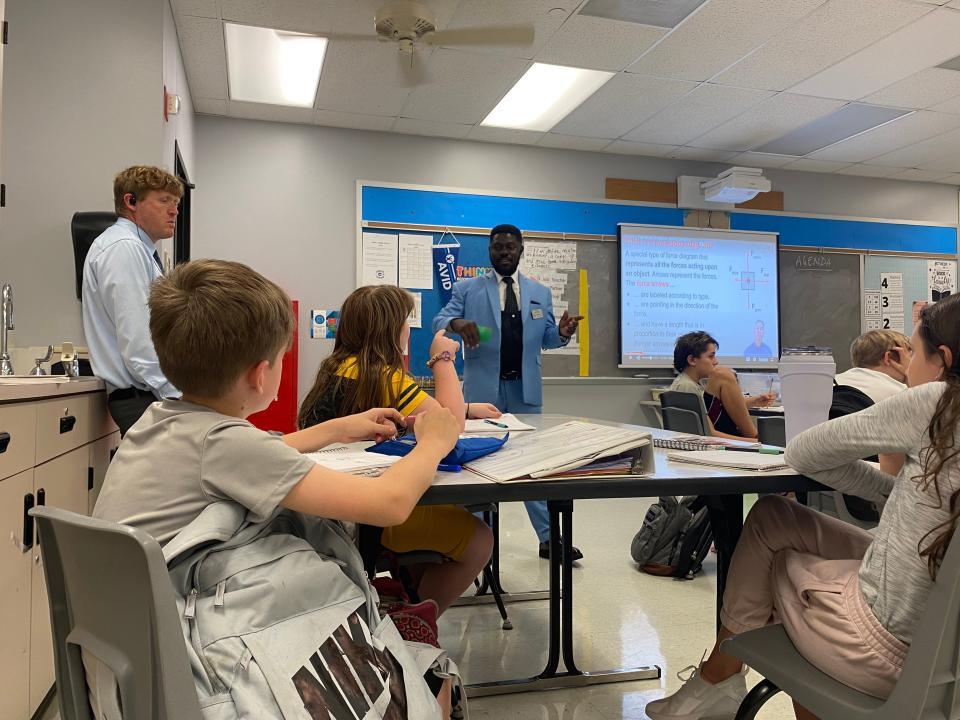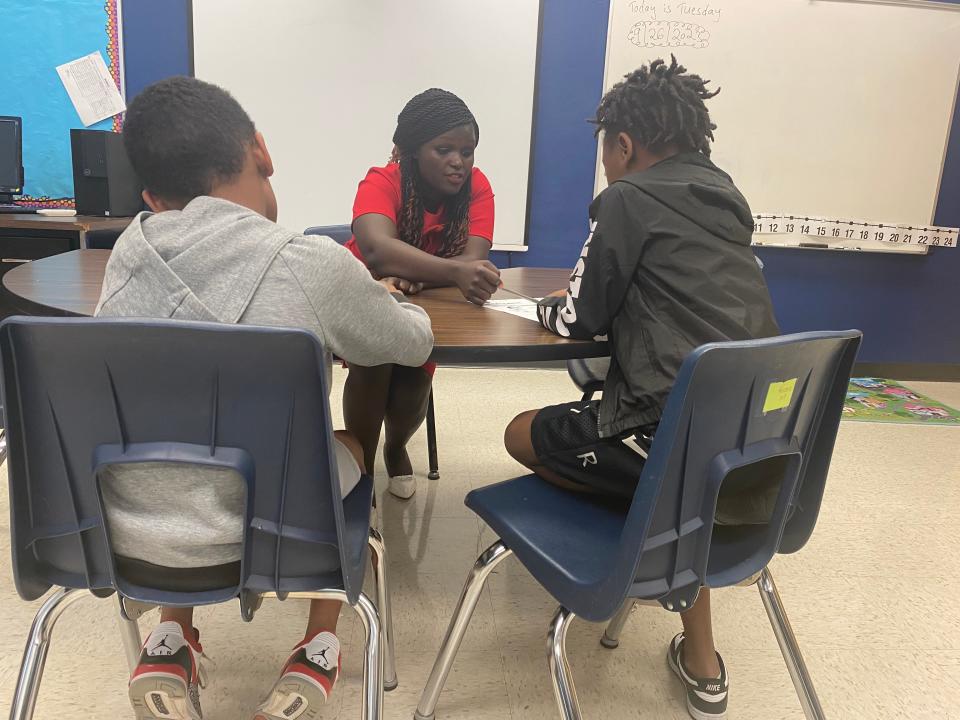How CPS is supplementing teaching ranks, boosting diversity with international teachers
For many years, Columbia Public Schools officials have tried to get teachers of color in classrooms, to provide representation for the minority student population.
It has been a slow process with slow progress. A Grow Our Own Teacher program is meant to recruit future teachers from among current minority students. It results in just one or two new minority teachers each school year.
A new effort has placed 13 new teachers of color in CPS classrooms.
The lack of diversity among CPS teachers was the topic of the doctoral dissertation for Michelle Holz, CPS human resources director. She received her doctorate in education leadership and policy from the University of Missouri.
With a family background from Mexico and Guatemala, she said she thinks she's the first Latina among CPS' top officials.
"I grew up in the suburbs of Chicago and then I moved to Columbia," Holz said. "So one of my passions has always been the benefits of having teachers of color in classrooms not just for students of color, but also for you know, white students as well. I mean, everyone can benefit from having somebody culturally, linguistically different from you."
Diverse teachers
Making the teaching staff more diverse over time is her target, she said.
"It's been one of my goals, moving into this role that we hire, all-around the most qualified but then also taking into consideration hiring diverse applicants," Holz said. "And so when I looked at the data, the student population is 42% non-white, and there was only 8% around that number of teachers of color in CPS. So that's like a huge discrepancy. Right? It was not even close."
There didn't seem to be an easy solution, she said.
"There really aren't many people graduating from universities and colleges and if they do, they don't come to Columbia, right?" Holz said. "They go to bigger cities for many reasons where maybe they have family or they feel there's a bigger diverse population, those kinds of reasons."
Then she decided the reach needed to expand internationally.
The teachers are from Cameroon, Ghana, Kenya, Jamaica, Mexico, Panama, Australia and the Philippines. They teach science, social studies, math, business and computers, English, Spanish with learning specialists teaching students on special education plans.
The process began last year. After she received approval from Superintendent Brian Yearwood, her HR team researched agencies that supply international teachers, she said.
"So it kind of helps us in twofold," Holz said. "Our goal of, you know, increasing our diversity in our teaching staff but then also is helping us get highly-qualified professionals to teach content in areas that there's not as many candidates. So it was like twofold, right? I mean, it was like it's so amazing."
The teachers

Christian Nakeli taught students in his sixth-grade science class about free body diagrams. He explained that the diagrams represent all the forces acting on an object based on Newton's Laws.
"I want you to now draw a free body diagram for a moving car," Nakeli said.
The diagram has applied force, with an arrow pointing to the left. Normal force is depicted with an arrow pointed upward. Friction is represented by an arrow pointed right. Gravity is an arrow pointing down. A student drew the diagram on a white board.
"When the car is going to the right, the friction is opposite to the movement of the car," Nakeli said. "The engine of the car is actually applied force."
All planets have gravitational force, he said.
Nakeli is from Cameroon, in Africa.
Columbia is peaceful compared to a previous U.S. assignment in Maryland, he said.
"I want to really appreciate the human resources department" of CPS, Nakeli said. "They have been very helpful."
The district has helped set up a bank account and with transportation, he said.
"People here are very friendly," Nakeli said. "The administration and all the teachers are always willing to give a helping hand."
He taught in Cameroon for five years before his first teaching assignment in the U.S.
Holz has assisted every step of the way for his time in Columbia, Nakeli said.
"I have not seen this type of help" elsewhere, he said.
Nakeli also lends a helping hand, picking teachers up at the airport in Kansas City.

Naomi Kingori is a learning specialist at West Boulevard Elementary School, working with students with special needs.
She's from Kenya, where she has taught for 8 years.
She learned about the possible opportunity from a friend who was working at a school in South Carolina, she said.
"I started my journey," Kingori said. "The first step was to get a passport."
She had never considered traveling outside of Kenya, she said.
She arrived on Sept. 13.
In Kenya, teachers had to share a single computer, but here, she has her own desktop and laptop computers, she said.
"Everything I need, the district provides," she said.
She had some reticence, she said.
"I had fears of racism," Kingori said. "So far I have not seen any. I feel at home. I feel at home away from home."
She is able to easily find ingredients for her favorite Kenyan foods here and they are very inexpensive.
She's impressed with how well balanced the school lunches are here, she said.
Kingori has benefited the school, said Principal Morgan Neale.
"It's been a huge blessing to our school community" to have Kingori there, she said.
One child told her "Mrs. Neale, my new teacher is from where my daddy's from," she said.
In class, she talked with her students about the nutrients and water plants need and how they absorb them through their roots.
Invested in the program
Holz has picked up some international teachers at the airport.
"I want them to come here and feel welcome and embraced in like, they feel this connection," Holz said. "So it may not necessarily be like OK, why is the head of HR going to pick up someone? Because I want them to know how invested we are in this program, that they are really wanted here and I want them to feel that instantly. I don't want them to come and be scared and like 'why did I do this?' I want them to feel like 'oh my gosh, they really truly are embracing this partnership. They're really excited about this.'"
This is a pilot project, Holz said. The teachers' visas are good for three years, with an option to extend them for another two years. But neither party is obligated, she said.
The international teachers are treated just like domestic teachers, Holz said.
"They're on a one year contract," Holz said. "They need to meet performance goals. And if they don't, then just like any regular teacher, you know, we may need to separate,"
Likewise, some teachers may not like the arrangement, she said.
"They also could not sign their contract for the following year and say, You know what, I'm homesick or this isn't working out," Holz said. "I want to return to my country, right? So I mean, it's a two-way street."
Holz said she has high hopes for the effort.
"Everything's new," Holz said. "We've never done this before. So we're working through it together."
Roger McKinney is the Tribune's education reporter. You can reach him at rmckinney@columbiatribune.com or 573-815-1719. He's on X at @rmckinney9.
This article originally appeared on Columbia Daily Tribune: New initiative brings international teachers to Columbia classrooms

